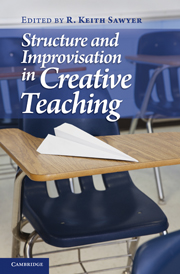Book contents
- Frontmatter
- Contents
- Table and Figures
- Notes on Contributors
- Foreword
- 1 What Makes Good Teachers Great?
- Part 1 The Teacher Paradox
- Part 2 The Learning Paradox
- Part 3 The Curriculum Paradox
- 10 How “Scripted” Materials Might Support Improvisational Teaching
- 11 Disciplined Improvisation to Extend Young Children’s Scientific Thinking
- 12 Improvisational Understanding in the Mathematics Classroom
- 13 Conclusion
- Index
- References
12 - Improvisational Understanding in the Mathematics Classroom
Published online by Cambridge University Press: 05 June 2012
- Frontmatter
- Contents
- Table and Figures
- Notes on Contributors
- Foreword
- 1 What Makes Good Teachers Great?
- Part 1 The Teacher Paradox
- Part 2 The Learning Paradox
- Part 3 The Curriculum Paradox
- 10 How “Scripted” Materials Might Support Improvisational Teaching
- 11 Disciplined Improvisation to Extend Young Children’s Scientific Thinking
- 12 Improvisational Understanding in the Mathematics Classroom
- 13 Conclusion
- Index
- References
Summary
In many mathematics classrooms, students learn largely by memorization; they memorize procedures, such as how to multiply two fractions, and they are then assessed by being presented with similar problems, which they can solve if they have memorized the procedure. The problem with this approach is that all too often, students fail to acquire any deeper understanding of mathematical ideas and concepts – for example, what does a fraction represent? How is it similar to a decimal, a ratio, or a percentage? What does it mean to multiply two fractions? Almost all experts in mathematics education agree that understanding mathematical ideas and concepts is a critical and desirable component of the mathematics classroom, yet teachers continue to struggle with meaningful ways to teach for mathematical understanding. Almost all teachers agree that understanding involves more than procedural knowledge and that it includes the ability to reason with and to make sense of what is learned, but the translation of this into concrete teaching strategies that can be implemented in the classroom remains a challenge.
- Type
- Chapter
- Information
- Structure and Improvisation in Creative Teaching , pp. 252 - 278Publisher: Cambridge University PressPrint publication year: 2011
References
- 7
- Cited by

